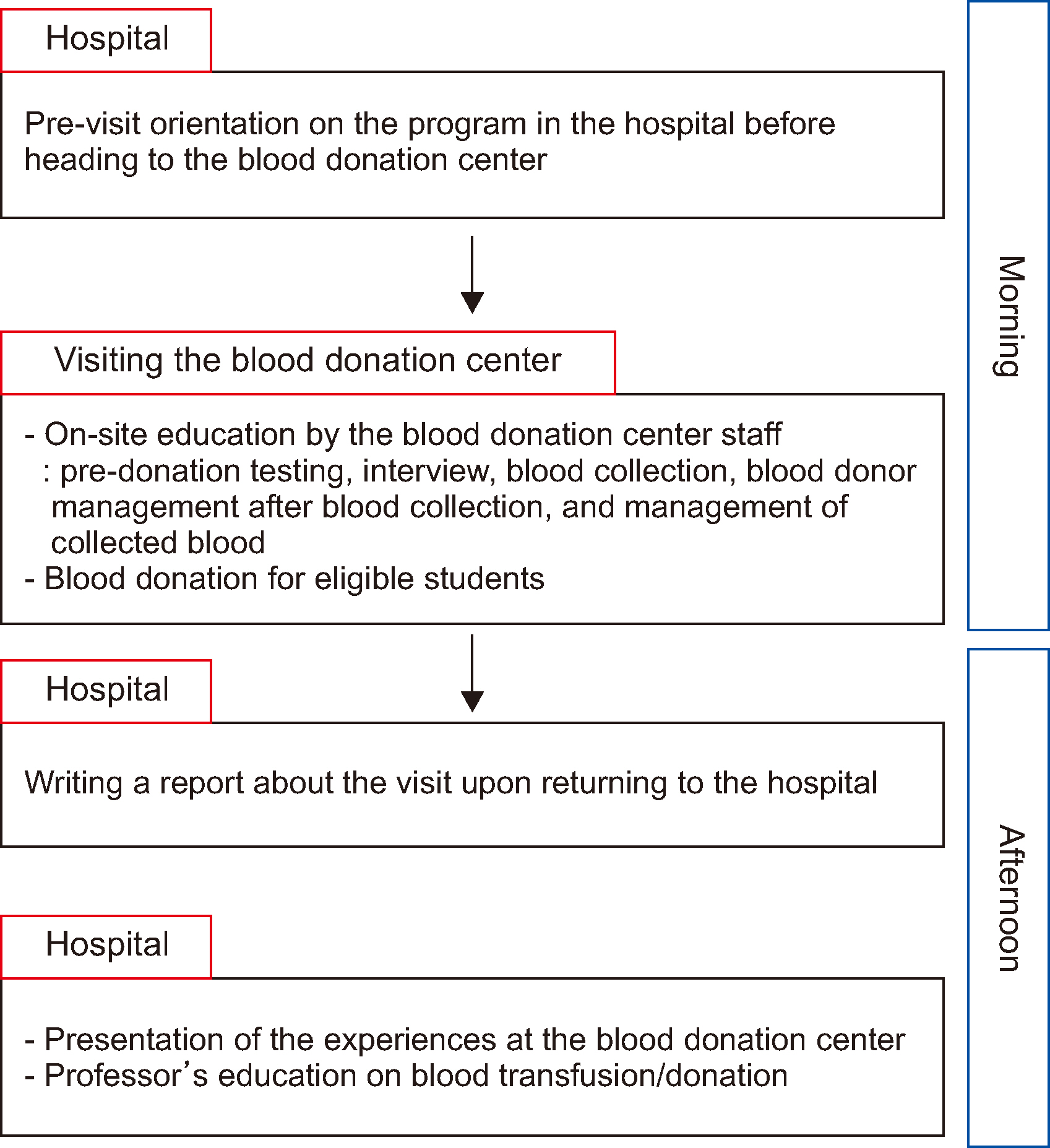Ann Lab Med.
2024 Sep;44(5):455-458. 10.3343/alm.2023.0355.
Educational Outcomes and Perception Changes in Medical Students After Visiting a Blood Donation Center
- Affiliations
-
- 1Soonchunhyang University College of Medicine, Cheonan, Korea
- 2Division of Hematology and Oncology, Department of Internal Medicine, Soonchunhyang University Seoul Hospital, Soonchunhyang University College of Medicine, Seoul, Korea
- 3Department of Laboratory Medicine, Soonchunhyang University Seoul Hospital, Soonchunhyang University College of Medicine, Seoul, Korea
- 4Division of Nephrology, Department of Internal Medicine, Soonchunhyang University Seoul Hospital, Soonchunhyang University College of Medicine, Seoul, Korea
- KMID: 2559153
- DOI: http://doi.org/10.3343/alm.2023.0355
Abstract
- Educating primary care physicians about blood donation and transfusion is critical. The Division of Hematology and Oncology at Soonchunhyang University Seoul Hospital in Korea introduced an on-site educational program termed the Blood Donation Center Visiting Program in the clerkship education for final-year medical students. We evaluated the educational outcomes and changes in perception among medical students after the Blood Donation Center Visiting Program based on a survey. The program was implemented from 2021 to 2023. As part of the program, students visited a blood donation center each week, one group at a time. They gained practical knowledge about the blood donation process, and some students actively participated in blood donation. After the program, 287 students were eligible for an online survey of the program, of whom 203 participated in the survey. Among the 203 students, 126 (62.1%) donated blood during their visit to the blood donation center as part of the program, and 88.7% of the students reported an increase (from 71.4% to 90.1%) in their knowledge and willingness to donate blood. The onsite educational Blood Donation Center Visiting Program appears to have generated positive changes in perceptions among students and enhanced their knowledge about blood donation.
Keyword
Figure
Reference
-
References
1. WHO. Maintaining a safe and adequate blood supply and collecting convalescent plasma in the context of the COVID-19 pandemic. Interim guidance. https://www.who.int/publications/i/item/WHO-2019-nCoV-BloodSupply-2021-1. Updated on 17 Feb 2021.2. Blood Services Statistics 2022. https://www.bloodinfo.net/knrcbs/na/ntt/selectNttList.do?mi=1158&bbsId=1061&nttSn=501629.3. Bae HJ, Ahn BS, Youn MA, Park DY. 2021; Survey on blood donation recognition and Korean Red Cross' response during COVID-19 Pandemic. Korean J Blood Transfus. 32:191–200. DOI: 10.17945/kjbt.2021.32.3.191.
Article4. Taş A, Evci Kiraz ED. 2018; Are future doctors ready to donate blood and encourage blood donation? Transfus Apher Sci. 57:569–72. DOI: 10.1016/j.transci.2018.06.004. PMID: 30244714.
Article5. Chauhan R, Kumar R, Thakur S. 2018; A study to assess the knowledge, attitude, and practices about blood donation among medical students of a medical college in North India. J Family Med Prim Care. 7:693–7. DOI: 10.4103/jfmpc.jfmpc_54_17. PMID: 30234039. PMCID: PMC6132011. PMID: 9351f0c1e713478da01f763124456f29.
Article
- Full Text Links
- Actions
-
Cited
- CITED
-
- Close
- Share
- Similar articles
-
- Factors Affecting Blood Donation Intentions of Nursing College Students
- A Study on the Job Satisfaction of Visiting Nurses of Public Health Centers in Korea
- Factors Affecting Blood Donation in University Students
- The Effect of Knowledge and Altruism on the Blood Donation Behavior among High School Students
- Affecting Factors on the Willingness to Platelet Apheresis


